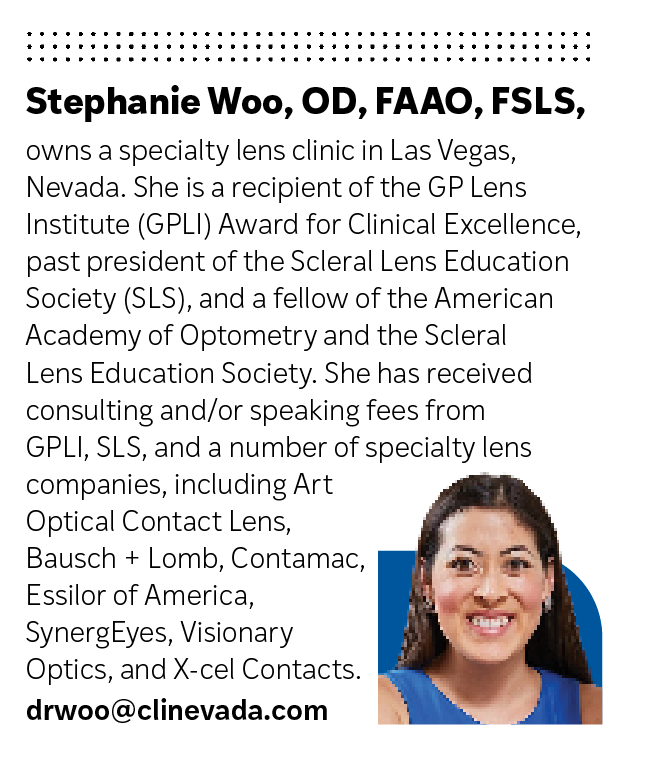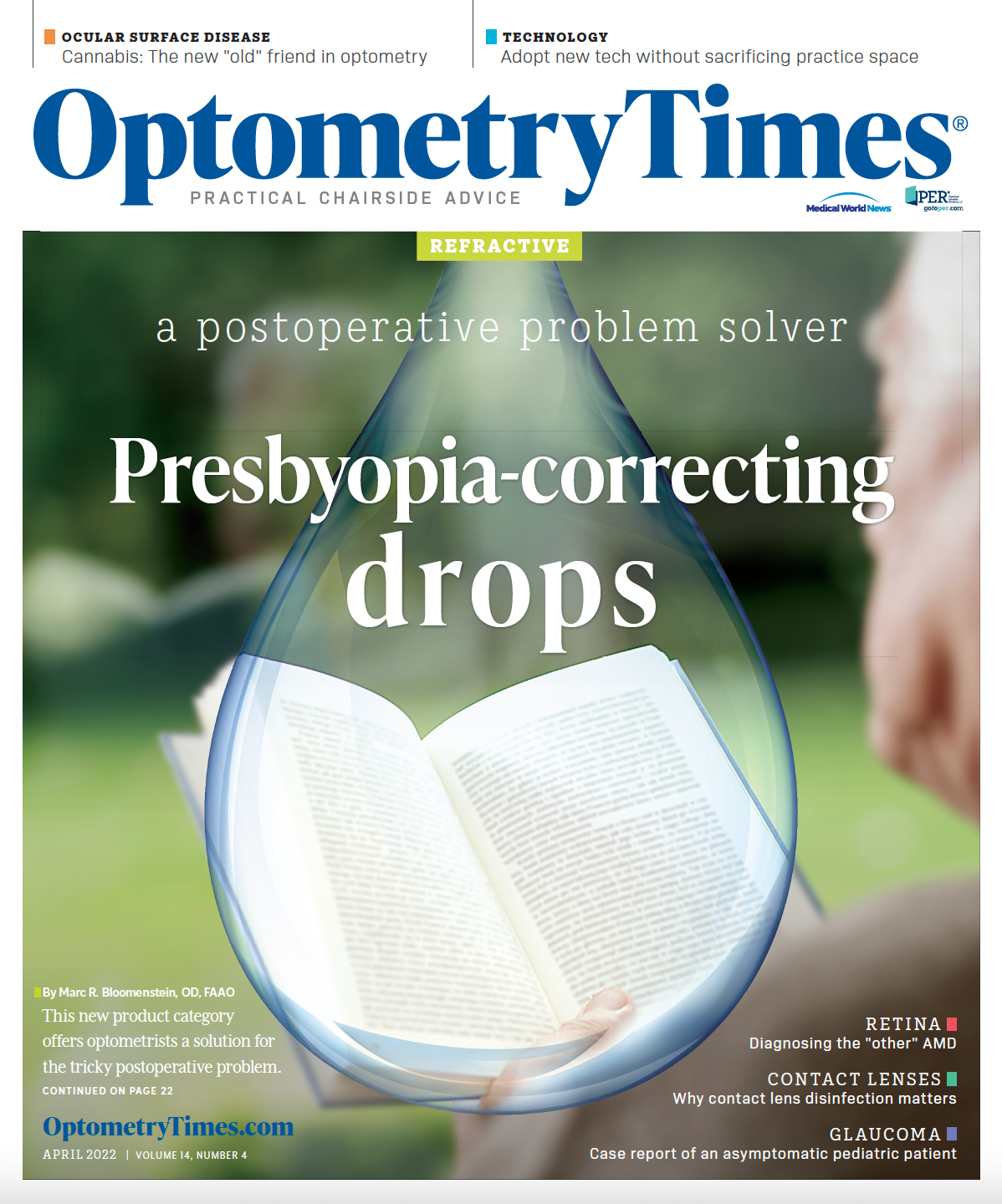Business basics: understanding how to manage and code for keratoconus
Build a stronger practice, generate revenue, and help patients avoid vision loss


Treating patients with keratoconus (KC) is one of my favorite things to do as an optometrist. It is so rewarding to be part of the patient’s journey, especially when you have the opportunity to identify the disease early, refer them for a cross-linking procedure, and prevent further progression.
While managing KC may involve prescribing contact lenses or spectacles, it requires much more of a medical outlook compared with managing typical vision correction. To properly bill, practices should consider accepting medical insurance, not just vision insurance. In fact, treating these patients can be an essential part of a practice’s transition to a medical model. Be aware that each insurance company has its own guidelines, reimbursement rules, and fee structures. KC management fosters stronger relationships with surgeons and cornea specialists and builds your reputation in the community as someone who can be trusted with complicated cases.
Diagnosis
Access to topography is essential for KC diagnosis and management. I strongly recommend that optometric practices that don’t currently offer this diagnostic service consider acquiring a topographer in 2022.
These devices can be used for multiple indications—not only for diagnosing KC, but for evaluating corneal scars, pterygium, and irregular astigmatism; evaluating patients pre– and post-laser vision correction; and performing specialty lens fitting.
If cost is a barrier, you can acquire an older, less expensive model or consider one that also offers autorefraction and autokeratometry so it can fulfill multiple tasks within the practice. Additionally, Glaukos Corporation, in partnership with Topcon Positioning Group, offers special topography pricing as part of the iDetect KC program. For more information on this, contact idetectkc@glaukos.com.
As a last resort, if no funding is available to purchase a topographer, you can send the patient to another eyecare professional in the area. Establish a relationship with a fellow colleague and explain your situation. I would typically send the patient to the referral site, and that site would perform a topography and then send me the results..
Topography has a separate, bilateral code (92025) that should always be billed when performed. KC can present asymmetrically but is almost always bilateral, so both eyes should be examined even if a cone is apparent only in 1 eye.
A reasonable approach in a primary care practice would be to develop a screening process that allows you to identify red flags and risk factors among routine vision care patients. These risk factors would include the following:
» Young age with high myopia or high or rapidly changing astigmatism
» Best-corrected vision worse than 20/20 with no other explanation
» Complaints of “distorted” vision
Patients with any of these risk factors should be brought back for a separate appointment to more closely evaluate their corneas, with additional acuity testing, topography, and retinoscopy. This would be coded as a Level 2 or 3 office visit using the 99XXX evaluation and management codes.
If topography shows evidence or suspicion of KC in the patient, especially in a young patient, refer them right away for even more advanced testing that includes tomography and a corneal collagen cross-linking evaluation. While not necessary for referral, providing documentation of progression could help provide timely information that may be needed for insurance companies to allow cross-linking. Because keratoconus can progress so rapidly, I typically bring the patient back for another examination within 3 months rather than waiting a full year and risking vision loss.
Cross-linking is the only way to slow or stop the progression of KC. Even when patients can see well with specialty lenses, they should be offered cross-linking as an option if they are progressing. At this time, only the epithelium-off procedure with the iLink technology (Glaukos) is FDA-approved and covered by insurance in the United States. After cross-linking, these patients will return to the optometric practice for long-term management, including vision correction. Older patients who have not progressed significantly may be treated in the practice without cross-linking, but should still be carefully observed for evidence of progression.
Collaborative care
Collaborative care of cross-linking is very different from comanaging ophthalmic surgical procedures. Whereas an optometrist might collect a flat percentage of the fee for cataract surgery, which would then cover all follow-up visits—whether 1 visit or 10—during the 90-day global period, cross-linking does not have a global period. Each visit can be billed as an office visit with the appropriate complexity level. In many ways, this makes for a streamlined billing experience because the optometrist can code follow-up care independently as office visits.
Follow-up and medication protocols after cross-linking are very similar to those followed after photorefractive keratectomy. The number and timing of visits will depend on your comfort level and relationship with the treating ophthalmologist.
An optometrist who is very comfortable comanaging cross-linking might see the patient for the 1-day follow-up and then again at 1 week to remove the bandage contact lens and confirm epithelial healing.
Additional visits could take place at 1 month and 3 months, and the patient can typically be refitted in specialty contact lenses at one of these visits. Each follow-up could be billed to insurance as a regular office visit using the 92XXX or 99XXX exam codes. Typical practice after the first 3 months could be to see the patient for an annual medical eye exam. Ongoing monitoring is necessary to ensure there is no further progression.
Specialty lens fitting
Scleral and other specialty lenses can help patients see their best, but they do require significant training, time, and skill to fit. Because they are considered refractive, specialty lenses are typically not covered by insurance or are only minimally subsidized. When billing insurance, the optometrist can bill for each visit and any testing performed.
The most common codes for these visits are 92072 (contact lens fitting for keratoconus) or 92313 (corneal scleral contact lens fitting). For a scleral lens specifically, the modifiers V2531 and RT or LT (right or left eye) are appropriate to use.
For patients whose insurance doesn’t cover specialty lenses or who are paying out of pocket, many doctors charge an umbrella fee that includes specialty lens fitting, the lenses, prescription or fit adjustments and remakes, insertion and removal training, and follow-up care for a specific period of time. It is important to go over all fees, including refund policies and warranty periods, with each patient.
Additional information on specialty lens fitting is available at workshops taught at major professional conferences or from fellows of the nonprofit Scleral Lens Education Society.
As part of “Woo University,” for example, I teach an 8-hour, in-person course on scleral lens fitting. The GP Lens Institute (GPLI) also has many excellent resources. Those with no time or desire to learn specialty lens fitting can use the locator services on ScleralLens.org and GPLI.info to find colleagues who offer specialty fitting.
KC management offers optometrists a great opportunity to help patients see their best and aim to avoid preventable vision loss, while also diversifying offerings and building a stronger practice.

Newsletter
Want more insights like this? Subscribe to Optometry Times and get clinical pearls and practice tips delivered straight to your inbox.